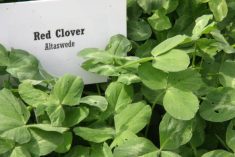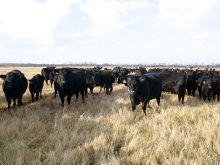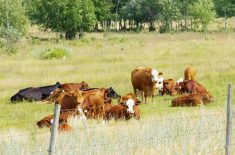PONOKA, Alta. — Alberta’s forage insurance payouts should reflect what it costs to replace forage rather than previous year’s prices, says a Rimbey farmer.
Chris Simpson said he was paid four cents a pound for lost hay after he made a claim through his AFSC forage insurance plan this year following a drought that decimated his hay crops.
He estimates it cost nine to 10 cents a pound to replace hay in his area this year and wants the payout to reflect replacement costs.
“Four cents a pound isn’t even in the ball park this year for what replacement feed will cost,” said Simpson, who presented a resolution at the Alberta Beef Producers meeting reflecting his request.
Read Also

Farming Smarter receives financial boost from Alberta government for potato research
Farming Smarter near Lethbridge got a boost to its research equipment, thanks to the Alberta government’s increase in funding for research associations.
“The pricing compensation should reflect what it takes to replace the lost production, not a set value of what hay was worth a year earlier.”
Instead of basing the payout on last year’s feed costs, Simpson wants it to be based on AFSC’s quarterly AgriStability price list of fair market values for crops in each region of the province.
“We need a methodology that would be more beneficial and truly represent what the loss is,” he said.
“I take forage insurance because I need the feed to feed my cattle. The reason I take the insurance is if I have a shortfall, I’ve got funds to replace that feed source. In a drought year, it doesn’t go very far. Any alternative sources of feed are worth more in a drought year, regardless of what it is.”
Simpson used the forage insurance payout money to buy silage for his cattle instead of hay, but he said it wasn’t close to what he needed.
Chris Dyck, senior manager with AFSC in Lacombe, said the agency is reviewing the discrepancy of payouts for lost hay and replacement hay, especially in a drought year.
“In a drought year when feed is short, feed is more expensive,” Dyck said.
A variable price benefit feature is built into the hay and pasture insurance program. Producers often look for other feed as a substitute when hay prices rise, which also increases in price.
The variable rate benefit kicks in if the price of barley increases 10 percent, and an additional payment is made.
Dyck said the agency reviewed barley prices in October and will soon decide if it will trigger an additional payment for those who took the insurance.
“It’s not finalized, but it looks like barley will trigger the variable forage price benefit this year,” he said.
AFSC, which looks after crop insurance in Alberta, said it has struggled to find ways to increase farmers’ use of hay and pasture insurance and has launched a review of the program. Only five percent of hay and 25 percent of pasture is covered by insurance.
Instead of insuring on an acreage basis, the agency is looking at insuring on a feed requirement basis for the amount of cattle on the farm.
It is also looking at modern technology such as satellite imagery to improve the insurance system.
As well, Dyck said the agency is looking at the difference in hay production. Some hay has little fertilizer added and other hay, grown for export, is more expensive to grow and needs more coverage.
“We treat all types of hay the same.”
The review will also look at coverage in the establishment year and if there should be payment differences for quality versus quantity.
Contact mary.macarthur@producer.com

















